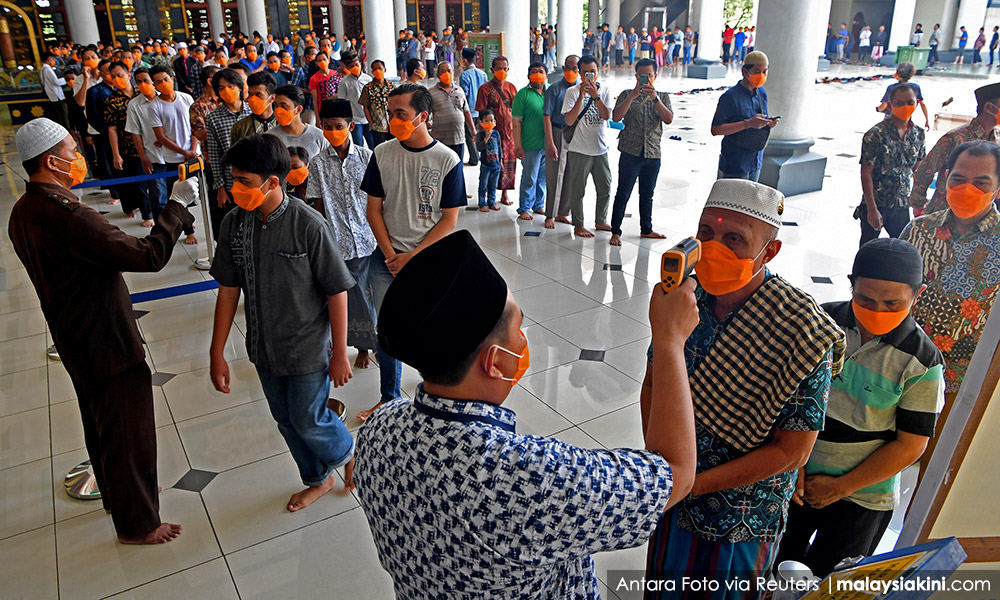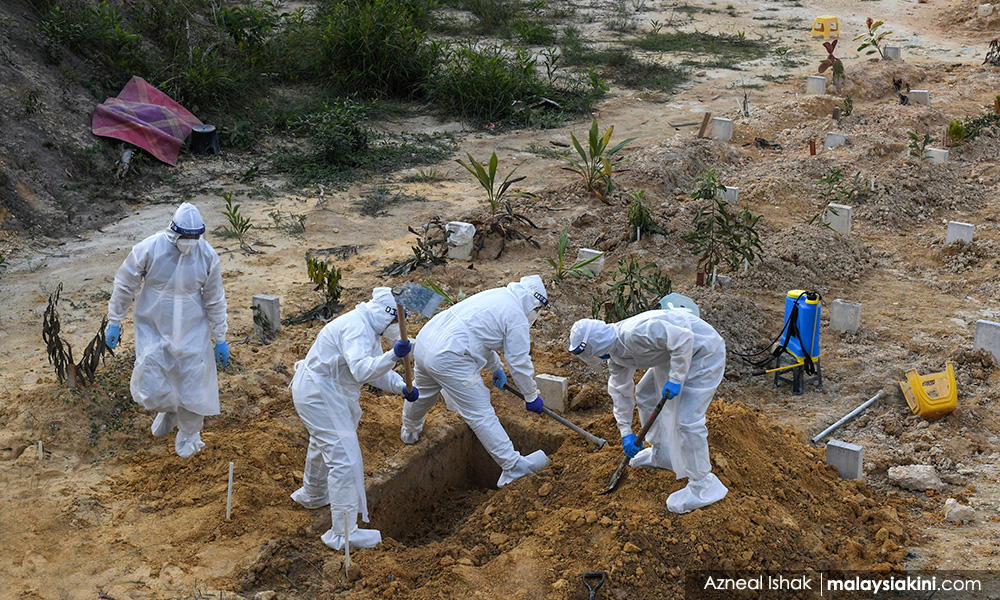This is a weekly round-up of Covid-19 related matters in Malaysia and globally from May 29 up to noon today. In Malaysia, case numbers are nearing 600,000 and globally, the virus has infected more than 172 million people and caused over 3.7 million deaths. More than 216 countries and territories are affected by the pandemic.
As the first phase of the full movement control order enters its fourth day today, Malaysia is still grappling with copious new Covid-19 cases and three-digit fatalities daily.
Yesterday, 8,209 new infections were reported nationwide with Selangor’s number surging to 3,125. Kuala Lumpur accounted for 801 cases and Johor 752.
During the week under review (May 29 to June 3), a record-breaking 9,020 new cases were reported on Saturday (May 29). On Wednesday (June 2), another unwanted record was broken when 126 fatalities were recorded – the highest number of deaths reported on a single day since the start of the Covid-19 outbreak in Malaysia on Jan 25, 2020.
Yesterday, 103 fatalities were recorded nationwide, with Selangor reporting the highest number (26).
As of yesterday, Malaysia’s cumulative Covid-19 cases stood at 595,374 and active cases 83,331.
Health director-general Dr Noor Hisham Abdullah has said that it will take three to four months to flatten the Covid-19 curve as the infection is already widespread in the country.
The matter has been compounded with the detection of new Covid-19 variants of concern (VOC) and variants of interest (VOI) in Malaysia, as pointed out by Noor Hisham on May 31. The Ministry of Health (MOH) has described the VOC as highly transmissible.
According to Noor Hisham, MOH has so far identified 119 cases caused by VOC (104 cases) and VOI (15 cases). Out of the 119 cases, 14 were imported. Selangor recorded the highest number of such cases at 42, followed by Sarawak 20 and Kelantan 18.
He said that a VOC identified as B.1.351 has been detected in every state in Malaysia.
With the implementation of the first phase of the full MCO from June 1 to 14, the government hopes to subdue the aggressive transmission of Covid-19.
Under the new movement controls, all social and economic sectors – except for those listed as critical by the National Security Council – have been closed.
The World Health Organisation has listed four VOC, namely B.117 (United Kingdom), B.1.351 (South Africa), P.1 (Brazil) and B.1.617 (India).
According to WHO, the Indian B. 1617 variant has been detected in 60 territories and countries while UK’s B. 117 variant has been found in 149 nations and territories. The South African variant has been found in 102 nations and territories and the Brazilian in 59.
In Malaysia, the admission of Covid-19 patients into the intensive care unit has also been rising steeply. As of yesterday, 880 patients were in the ICU with 446 requiring respiratory aid.
With its 595,374 cumulative cases, Malaysia now occupied the 39th spot on the list of 216 countries affected by the Covid-19 pandemic. Just ahead of Malaysia is Austria (645,834 cases).
Malaysia’s rising Covid-19 death rate, as well as the increase in the number of patients requiring critical care and ventilators, is a cause for concern.
The record 126 fatalities registered on June 2 involved 123 Malaysians and three non-citizens. Twenty-one cases were categorised as BID or brought in dead. These cases refer to patients who died before they were brought to the hospital and the cause of their death was determined during post-mortem examination.
Yesterday, 103 deaths were recorded, bringing the Covid-19 death tally to 3,096 (0.52 percent of total cases). Fifteen of the fatalities were categorised as BID.
Following is the daily breakdown of deaths over the week under review: 98 (May 29); 79 (May 30); 67 (May 31); 71 (June 1); 126 (June 2); and 103 (June 3).
Throughout the week, Selangor accounted for the highest number of deaths, that is, 27 (May 29), 15 (May 30), 15 (May 31), 28 (June 1), 29 (June 2) and 26 (June 3).
Local transmissions continued to contribute to daily new Covid-19 cases reported nationwide throughout the week under review, making up about 90 percent of new infections.
Out of the 8,209 new cases reported yesterday, 8,145 comprised locally transmitted infections (involving 7,046 Malaysians and 1,099 non-citizens).
Following is the breakdown of new cases, imported cases and local transmissions over this week.
Saturday (May 29): New cases 9,020; imported cases five; local transmissions 9,015 (8,346 or 92.6 percent citizens and 669 non-citizens).
Sunday (May 30): New cases 6,999; imported cases four; local transmissions 6,995 (6,385 or 91.3 percent citizens and 610 non-citizens).
Monday (May 31): New cases 6,824; imported cases three; local transmissions 6,821 (6,239 or 91.5 percent citizens and 582 non-citizens).
Tuesday (June 1): New cases 7,105; imported cases two; local transmissions 7,103 (6,550 or 92.2 percent citizens and 553 non-citizens).
Wednesday (June 2): New cases 7,703; imported cases two; local transmissions 7,701 (6,861or 89.1 percent citizens and 840 non-citizens).
Thursday (June 3): New cases 8,209; imported cases 64; local transmissions 8,145 (7,046 or 86.5 percent citizens and 1,099 non-citizens).
It is encouraging to note that the number of recoveries is also on the rise.
Yesterday, a whopping 7,047 patients were discharged from hospital, bringing the total number of recoveries to 508,947 (85.5 percent of total cases).
Still many new clusters
On May 29, MOH reported that a total of 51 clusters, involving 6,468 cases, linked to interstate travel has emerged since Dec 7, 2020,
According to MOH, the interstate clusters included those with index cases that had returned to their hometowns to celebrate Hari Raya Aidilfitri, visited family members and attended weddings, birthday functions, funerals, courses or talks.
Between April 1 and 28 this year, 20 clusters linked to interstate travel involving 1,420 cases were reported.
Malacca reported the highest number of such clusters at eight (40 percent), followed by Terengganu three and Kelantan, Perak and Pahang two each.
Yesterday, 24 new clusters were reported, 19 of them linked to the workplace.
Over the week under review, workplace clusters accounted for 71 (54.4 percent) of the 138 new clusters reported.
Following are details of the clusters reported this week:
May 29: 23 new clusters (eight workplace, eight community, six religious and one education).
May 30: 17 new clusters (six workplace, seven community, two religious, one education and one high-risk group).
May 31: 25 new clusters (14 workplace, seven community, nine religious, one education and one high-risk group).
June 1: 27 new clusters (13 workplace, eight community, three religious, two education and one high-risk group).
June 2: 22 new clusters (11 workplace, seven community, one religious, two education and one detention centre).
June 3: 24 new clusters (19 workplace, four community and one education).
As of yesterday, the nation has recorded a total of 2,261 clusters of which 1,578 have ended while 683 are still active.
Meanwhile, Noor Hisham wrote in his personal Facebook account yesterday that the nationwide Covid-19 infectivity rate or R0/Rt value remained at 1.06 as of yesterday. Labuan had the highest R0 value at 1.35, followed by Negeri Sembilan at 1.22 and Sabah 1.13.
Covid-19 case details in Malaysia
Selangor continued to account for the highest number of new Covid-19 cases reported daily.
The daily breakdown of new cases reported by Selangor over this week is as follows: May 29 (2,836 ), May 30 (2,477), May 31 (2,111), June 1 (2,068), June 2 (2,728) and June 3 (3,125).
Other states that recorded three-digit new cases yesterday were Kuala Lumpur with 801 cases, Johor 752, Sarawak 594, Negeri Sembilan 576, Kelantan 414, Perak 384, Kedah 373, Malacca 322, Penang 303, Sabah 203, Pahang 135 and Terengganu 127.
Labuan, meanwhile, reported 62 cases, Putrajaya 33 and Perlis five.
Global Covid-19 statistics
The total number of Covid-19 cases worldwide, according to Worldometer, at the time of writing this article stood at 172,896,909 (169,710,788 cases at the same time last Friday) and deaths 3,717,053 (3,527,082 last Friday). The total number of recoveries stood at 155,603,740.
Some 216 countries are affected by the Covid-19 pandemic and those in the top 10 of the list are the United States, India, Brazil, France, Turkey, Russia, the United Kingdom, Italy, Argentina and Germany. The breakdown is as follows: United States 34,174,752 cases (611,611 deaths); India 28,572,359 (340,719); Brazil 16,720,081 (467,706); France 5,685,915 (109,758); Turkey 5,263,697 (47,768); Russia 5,099,182 (122,660); United Kingdom 4,494,699 (127,794); Italy 4,223,200 (126,283); Argentina 3,852,156 (79,320); and Germany 3,698,004 (89,510).
China, where the outbreak was first reported at end-December 2019, is now on the 98th spot in the list of countries affected by Covid-19 with 91,194 cases while its death toll remained at 4,636.

Besides Malaysia, the four other Southeast Asian nations that have joined the list of 93 countries with more than 100,000 cases are Indonesia (18th spot) with 1,837,126 cases and 51,095 deaths, the Philippines (24th spot) with 1,247,899 cases and 21,357 deaths, Thailand (81st spot) with 169,348 cases and 1,146 deaths and Myanmar (85th spot) with 143,945 cases and 3,221 deaths.
Singapore (106th spot) has reported 62,145 cases and 33 deaths; Cambodia 32,189 cases and 236 deaths; Vietnam 8,063 cases and 49 deaths; Laos 1,943 cases and three deaths; and Brunei 244 cases and three deaths.
Covid-19 background
The World Health Organisation’s China country office was informed of cases of pneumonia that were detected in Wuhan on Dec 31, 2019. On Jan 7, the Chinese authorities confirmed that the newly detected novel coronavirus can be transmitted from human to human.
Coronaviruses are a large family of viruses that cause illnesses ranging from the common cold to more severe diseases such as Severe Acute Respiratory Syndrome (SARS) and Middle East Respiratory Syndrome (MERS-COV).
A study of the virus’ genetic sequence suggested similarities to that seen in snakes and bats. China health officials identified the Huanan Seafood Market in Wuhan as the source of the transmission of the coronavirus.
On Feb 11, 2020, WHO announced the official name of the virus, Covid-19, which is an acronym for coronavirus 2019 – CO stands for corona, VI for virus and D for disease.
On Jan 30, 2020, WHO declared the coronavirus outbreak as a global emergency and on March 11, Covid-19 was declared a pandemic.
WHO has described the Covid-19 outbreak as much more dangerous than the A H1N1 Influenza, also known as Swine Flu.
Swine Flu, which occurred between January 2009 and August 2010, infected more than 1.6 million people and caused 18,449 fatalities. It was first detected in Mexico and later in the United States in March 2009.
Covid-19 was detected in Malaysia on Jan 25, 2020, when three Chinese citizens, who had entered Malaysia through Johore from Singapore on Jan 23, were tested positive for the disease.
New variants of the Covid-19 coronavirus have since emerged in the United Kingdom (identified as B117) in September 2020, South Africa (501Y.V2) in October 2020 and India (B.1.617), also in October last year.
- Bernama




No comments:
Post a Comment
Note: Only a member of this blog may post a comment.